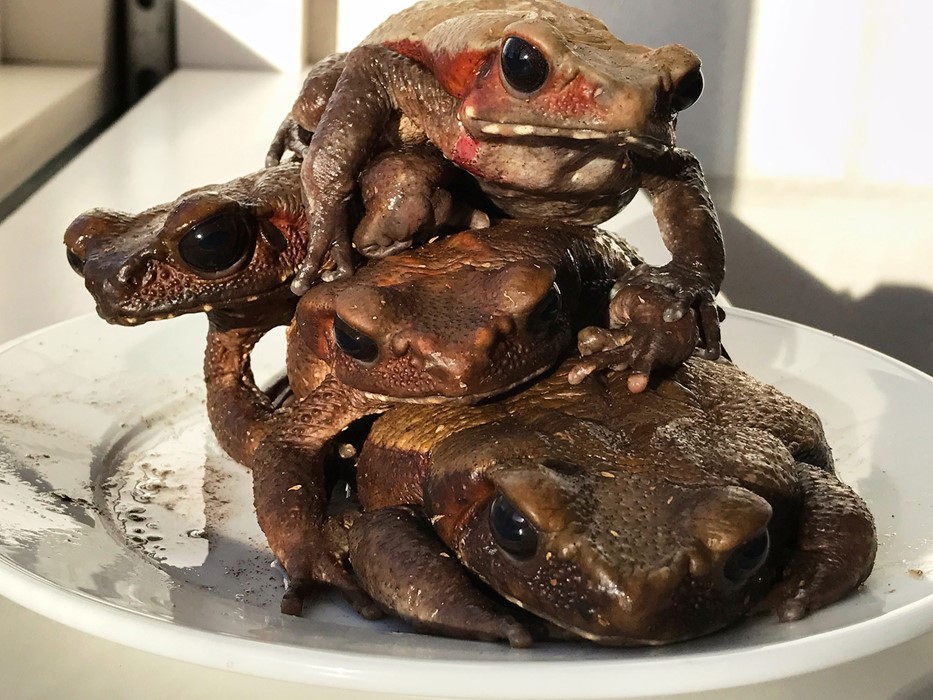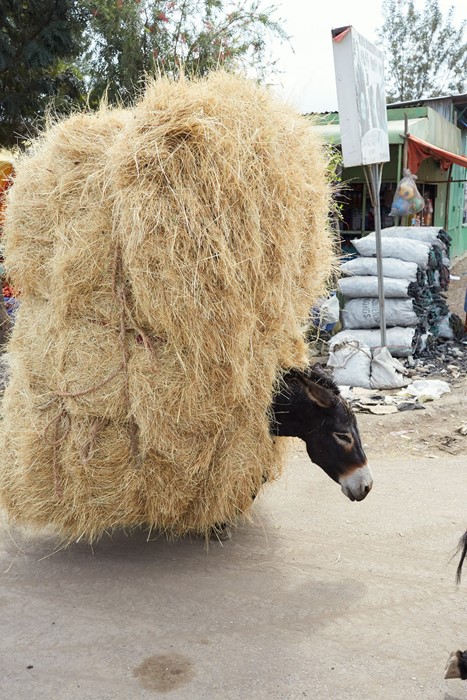To coincide with a brilliant Berlin retrospective of his work, we reveal ten things you might not know about the inimitable German image-maker
Since rising to fame in the early 90s, German image-maker Juergen Teller has continued to delight viewers with his idiosyncratic, uncompromising brand of photography, whether shooting personal series about football or family or iconic fashion campaigns. His work is funny and moving, silly and serious, and always surprising. Give him Kanye and Kim and he’ll take them hiking along dusty riverbanks. Give him Victoria Beckham and he’ll hide her in a giant shopping bag. Give him Björk and he’ll ask her to eat a vast pile of squid ink spaghetti. Now, an exhibition at Berlin’s Martin-Gropius-Bau, titled Juergen Teller: Enjoy Your Life! offers a unique chance to trace Teller’s artistic progression, from his early works right up to the present day. Like Teller’s pictures themselves, the show is a wonderfully intimate affair: an open gateway into the photographer’s world. Here, we reveal ten lesser-known facts we gleaned upon visiting.

1. He nearly became a bow-maker
Teller was born in 1964 in Bubenreuth, near Erlangen, an area famed for the production of Franconian stringed instruments. His family were instrument-makers, and he himself began training as a bow-maker before ill health forced him to quit. He opted to study photography instead, attending the Staatslehranstalt für Photographie in Munich and moving to London in 1988 to kickstart his career.

2. Family is very important to him
Teller is a devout family man, and frequently turns his lens upon his kin. His mother Irene greets us in the show’s opening room, introducing her progeny with a large sign bearing his name. Elsewhere, she poses between the open jaws of an alligator, alongside various celebrities, and strolling through a Bavarian forest in a moving photo series accompanied by a short story about her maternal devotion. Elsewhere, the face of Teller’s baby son, Ed, stares down from a giant plate, while another plate depicting Teller’s penis resting on his wife Sadie Coles’ pregnant stomach is paired with a black-and-white photo of Kurt Cobain (Teller loves a strange juxtaposition).

3. He also likes plates – a lot
As hinted at above, Teller has an enduring fascination with plates. “A plate for him is like a kiss,” writes Francesco Bonami in an essay for the exhibition catalogue. “It’s simple, unavoidable, compromising, universal and sometimes dangerous.” It also appeals to the photographer’s sense of humour: the word “teller” in German means plate. Teller often gives his models plates to hold or pose with. Sometimes, as with the Cobain image, the crockery bears his own photographs, at others it is plain white; some plates are dinner-sized, others giant platters. The plates lend an air of playful intrigue to Teller’s portraiture. “The question is no longer who is [his subject] but what is he or she going to do with that plate,” Bonami notes.

4. He has an alter ego named Dieter
In an amusing video installation titled Dieter, Erlangen (2017) we see Teller don an unkempt grey wig, blue beanie, scruffy leather jacket and jeans, his feet decked in socks and sandals. He carries an Aldi shopping bag and speaks with a thick Franconian accent. This, we are told, is Dieter, Teller’s parochial alter-ego – an exaggerated version of how the photographer may have turned out had he never left his homeland. We watch the opinionated Bavarian shuffle around an exhibition of Teller’s work held in Erlangen earlier this year – the first to take place in his native town – proclaiming everything utter “scheiße”, save for the pictures of nude models. Teller had spoken of his fears surrounding the reception of his work by the locals, and this, it appears, is his way of making light of such worries.

5. He never retouches his imagery
Teller famously refuses to retouch his work – extending this policy to every commission, including covershoots of Hollywood stars. In another humorous exploit included in the show, we find the photographer taking a red and black sharpie to a self-portrait, which sees him lounging lazily in a leather armchair in a long fur jacket, legs akimbo, belly protruding. Comments such as “more hair”, “retouch stomach!”, “skin more healthy” and even “change head” form a spider diagram around his figure: a distinct dig at the fashion industry’s frequently ridiculous standards.

6. He is happy to bear all in his work – both literally and metaphorically
More often than not, Teller’s photography is deeply personal; as one picture of a white plate bearing the image-maker’s scrawl informs us, “Everything in a wider sense is a kind of self-portrait”. He often includes himself in his work, setting up the shot beforehand and delegating button-pushing responsibilities to a trusted cohort. He is also a fan of nudity, frequently using it, in the case of himself, to highlight vulnerability. There’s the famous image of him naked by his father’s grave, for example, or that of him lying undressed atop a donkey. In the case of the latter, a quick glance may elicit an amused response – until you notice the block of text printed alongside detailing a trip to Turkey, where Teller was sexually assaulted after accepting a ride on a donkey.

7. His fashion campaigns often form part of wider series
Part of what makes Teller so brilliant is his ability to freely traverse the boundaries between art and commercial photography. He often pokes fun at the fashion world, and yet he respects it, freely embracing fashion imagery into his broader oeuvre. He will often shoot his campaigns as part of ongoing series, thereafter publishing the works in their entirety as books (think: Louis XV, featuring his 2004 campaign for Marc Jacobs, or The Flow, which includes his A/W15 campaign for Louis Vuitton).

8. He knows how to gain his subjects’ trust
“The only thing that’s important is… that you get into [your sitter’s] psyche – who the person is themselves,” Teller told Hans Ulrich Obrist in an interview for System magazine.” And in order to do this, he explains, you must gain their complete trust. Teller, it is safe to say, has mastered this art: he has photographed a majestic Vivienne Westwood in the nude, cajoled Adrian Searle into enormous platforms and out onto a busy street for a portrait, and even persuaded his longtime muse Charlotte Rampling to let him “kiss and stroke” her breasts in the name of art. (“It was the stupidest thing I’ve ever said and I started sweating,” he said later, “[but] Charlotte elegantly lit a cigarillo, took a drag and said, ‘OK with me, but I’ll tell you when to stop.’”) Teller treats his protagonists as equals, and as such yields amazing results. As Searle explains in an essay for the catalogue, “Part of me wants him to go further, to push the situation. He makes collaborators of us all.”

9. He’s a self-professed control freak
Teller is notoriously meticulous about how he operates – it must be done his way or not at all – and he works only with those who allow him creative carte blanche. For years he shot resolutely in analogue, for example, only experimenting with digital photography in 2015 when film stock changed and forced him to branch out. Similarly, he only ever shoots with one assistant (and occasionally with the extra support of his wife Sadie) and never allows anyone to take an unsolicited photograph of him. He also believes in being involved in any project that bears his name, closely overseeing every photo book or exhibition of his work. And this singular approach has seldom failed him.

10. But he’s not afraid to improvise
That said, when things go awry, Teller is happy to freefall. The exhibition’s final room is the perfect demonstration of this fact: a vast, psychedelic space pasted with images of leafy forestry, dotted with naked women carrying hula-hoops, alongside still-lifes taken in a marijuana factory, as well as more conventional fashion shots. This diverse but somehow complementary melange, we find out, is Teller’s answer to Rihanna unexpectedly cancelling a cover shoot for System magazine. Refusing to admit defeat, the photographer took what he had – some willing models and a killer location (a 60,000 square foot medical cannabis facility in the Canadian countryside) – and created a spectacularly inventive story titled Waiting for Rihanna. As the accompanying text states, “There’s creativity in the art of embracing the unexpected.” And that is just what Teller is best at.
Juergen Teller: Enjoy Your Life! is at the Martin-Gropius-Bau, Berlin until July 3, 2017. The accompanying catalogue, published by Steidl, is available now.
